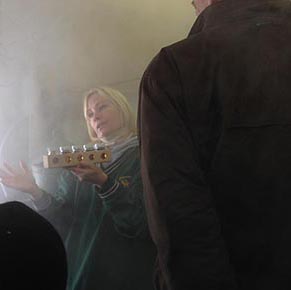
Best wishes, Tim Murphy!
Best wishes to Tim Murphy, a longtime Providence Journal editor, notable for his intelligence, calm and quiet humor. A delightful gent, much beloved by his colleagues.
He retired last week, joining the throng of senior editors who have left newspapers in the past several years as these institutions morph into smaller and primarily digital creatures, even as most of their revenue continues to come from the good old-fashioned (and easier to read) print on paper.
Llewellyn King: An answer to Chinese domination of rare earths
Rare earth elements – there are 17 of them – have the world’s manufacturing by the throat. They are, as John Kutsch, director of the Thorium Energy Alliance, says, “the great multipliers.” They make metals stronger, generators more efficient, cell phones smaller, television sets sharper, and laptops lighter. They are, in their way, as important to modern manufacturing as energy.
At one time, the United States was a major supplier of rare earths -- with supplemental supplies coming from countries around the world, including Australia and Brazil. Today, 90 percent of the rare earths the world uses come from China.
The use of rare earths is as important in lasers and jet engines as it is in aiming cruise missiles, which means the United States, and the rest of the world, has a huge vulnerability: China controls the supply of new war-fighting material. All U.S. defense manufacturers – including giants Boeing, General Electric and Lockheed Martin -- are dependent on China. Now China is demanding that U.S. companies do more of their manufacturing there: China wants to control the whole chain.
Yet, as the rare earth elements industry is quick to assert, rare earths are not rare; they are scattered generously throughout the world. So why China’s dominance?
China has three main advantages. The first is that in 1984, leader Deng Xiaoping adopted a major initiative, the so-called 863 Program, to move China from being a simple supplier of raw materials and products, enhanced by cheap labor, to being an industrial powerhouse and scientific giant. Rare earths were one of the areas singled out in the program.
The second advantage is that the Chinese ignored – and, to a large extent, still do -- the environmental costs of rare earths' extraction. The environmental damage is described by those who have been to one of two major Chinese sites, which have a combined population of 17 million, as catastrophic, with mountains bathed in acid to remove the sought-after rare earths, resulting in lakes of acid.
China's third advantage is a natural one: It has a lot of ionic clay, which contains rare earths without the associated uranium and thorium.
About the time China was ramping up its plans to dominate the world rare earths market, the United States, in conjunction with the International Atomic Energy Agency, based in Vienna, began to regulate so-called source materials. These are materials which, at least in theory, could be fashioned into weapons. In reality, those associated with rare earths are not in sufficient quantity to interest potential proliferators.
But the regulations are there. Many in the rare earths elements industry believe that it was these regulations -- particularly as affecting thorium -- that crippled production around the world and essentially closed down the U.S. industry, just as demand was escalating.
There is a commercial market for uranium. While hardly any thorium is used nowadays, it was once used in some scientific instruments and mantles for lighting. Thorium is akin to uranium in atomic weight, and it is a fertile nuclear material. That means that it can be used in a nuclear reactor, but it has to be ignited by a fissile material, such as enriched uranium or plutonium.
Thorium is radioactive, but mildly so. It is an alpha emitter, which means it can be shielded with tissue paper and will not penetrate the skin. However, it has a half-life of 1.5 billion years.
The answer, according to James Kennedy, a science consultant and rare earths expert, is to develop a reactor using thorium instead of uranium. This reactor, called a molten salt reactor, is inherently safe, say its passionate advocates, and would be a better all-around nuclear future. The technology was pioneered by one of the giants of the early nuclear age, Alvin Weinberg, at the Oak Ridge National Laboratory, but abandoned under pressure from enthusiasts for light water reactors, the kind we have today.
The Thorium Energy Alliance believes that the United States and other countries should develop a cooperative to source rare earths from the existing mining of phosphates and metals and store the thorium until it becomes a useful fuel. A bill to do this is making its way through Congress, but its chances are slim. Short of putting a value on thorium and isolating it, the chances of a rare earths elements industry reawakening in the United States, or elsewhere, is rare.
Llewellyn King is executive producer and host of “White House Chronicle,'' on PBS. His e-mail is lking@kingpublishing.com.
Mobile: (202) 441-2703
Web Site: whchronicle.com
Robert Whitcomb: Small-college blues
“Sweet Briar’s planned orderly retreat starts to look more like a mad dash for the door.’’
-- Travis LaCouter, in “Sweet Briar Fails to Keep Up,’’ March 13 Philanthropy Daily
That fiscally anxious Sweet Briar College, in rural Virginia, will close demonstrates the challenges facing liberal (in the nonpolitical sense) higher education in our harsher, more competitive times.
Of course, every college has different strengths and challenges (thus avoid the promiscuously misleading U.S. News & World Report rankings); colleges can’t be compared with precision.
Sweet Briar, founded in 1901, is a women’s institution that has an outdated reputation as a finishing school for affluent young ladies who like horses. For many years it has strenuously sought out applicants from many backgrounds to benefit from the highly regarded, small-class teaching on its bucolic campus.
But it has found it increasingly difficult to compete with co-ed, larger, richer and mostly urban or suburban schools in general, let alone the eight Ivy League colleges, MIT, Stanford, Duke, the University of Chicago, Northwestern and perhaps a dozen other “brand-name’’ establishments, public (to wit, the very prestigious University of Virginia) and private. And Sweet Briar’s cutting its tuition (thus revenue) to try to stay competitive may have been a mistake.
Even elite schools say they worry about their fiscal futures because of free college courses on the Internet. But they’ll be okay: Their national name-dropping appeal will keeping drawing many students, especially from rich and powerful families. On their campuses students will cultivate the relationships that will keep them on top of the self-perpetuating American aristocracy/plutocracy.
Whatever the college, being “liberally educated’’ within an academic residential community is a strong foundation for an interesting and productive life. And while courses in, say, history and literature might not initially seem “practical,’’ if absorbed they can in fact be very useful – in developing critical thinking, clarity in expression and in dealing with life’s innumerable and often ambiguous issues. A more “vocational’’ course might teach you how to write software for social media that might get you a first or second job, but as with all techno courses, its value will swiftly shrink as new technology comes along amidst the corporate drive to maximize profits by laying off more people.
Someone broadly educated in the liberal arts (including what we used to call “general knowledge,’’ which seems scarce among too many of us) is well positioned to deal with what life unpredictably throws at us.
Students also benefit from being in a residential community from whose relationships they can draw lifelong career and emotional support.
Many argue that taking free or very cheap courses online offers the same value. Wrong! Actually being in the same room with a teacher and other students is a much richer experience in retention of learning and in developing long-term intellectual and social relationships. (And neurologists have shown that retention of material is considerably greater in reading on paper than on a computer screen.) The social atomization and superficiality associated with living online decays civil society.
None of this is to say that some liberal-arts colleges aren’t partly to blame for some of their own woes. They cost too much, in part because they hire far too many overpaid administrators. And too many offer stupid courses along the lines of “Transgendered Aesthetics in 1950’s Beat Culture,’’ etc., and country-club luxuries. And too many of them don’t demand that graduates demonstrate the sort of general knowledge that citizens of democracy should have.
Further, the silly idea pumped up by politicians and others that “everyone deserves the right to get a college degree’’ should be dumped. For plenty of people more vocationally focused post-high-school education is appropriate.
Still, for those with the desire to energetically participate as leaders in our society you can’t beat a good liberal-arts education. The decline of the small, intimate colleges that have been exemplars of this education is troubling. Many of those who think that a very specific vocational education will serve them better are likely to find their skills obsolescent in a surprisingly short time after graduation.
Robert Whitcomb (rwhitcomb51@gmail.com), overseer of these pages, is a partner at Cambridge Management Group, a health-care sector consultancy, and a Providence-based writer and editor. He's also a Fellow of the Pell Center for International Relations and Public Policy, a former finance editor of the International Herald Tribune and a former editorial-page editor of The Providence Journal.
Brutal winter means short maple-sap season
Judy Esposito gives a presentation in the sugarhouse.
Story and picture by CATHERINE SENGEL, for ecoRI News
CHEPACHET, R.I.
“The buds are getting heavy,” notes a recent visitor to Chepachet Farms, eyeing the tight red nubs on the branches of the maple trees that edge the barnyard.
It’s Saturday, March 21, the first full day of spring, but only the second time this syrup season that owner Neil Esposito has had enough sap to keep the tanks full and flowing over the fires in his sugarhouse.
Depending on the sugar content in a season’s sap, it takes an average of 40 gallons to produce a gallon of syrup. Trees need cold nights and warm days to set the sap rising from roots to branches. If the weather cooperates, runs can begin as early as late January or February.
This winter’s deep snows, frigid days and icy grip mean a harvest so late it will not last long. Once temperatures spike and buds swell, sap turns milky and sours, and the run is done.
Esposito boiled for the first time a week ago. Today’s morning snow and temperatures locked in the mid-30s means it’s past noon before the taps on the buckets by the house begin to drip. He’ll have enough sap to boil again tomorrow. To date, he’s collected 625 gallons of sap and made 13 gallons of maple syrup.
“You have to make the best of what you have, “ Esposito said.
He and his wife, Jody, began farming their five acres on Tourtellot Hill Road in 1993. Both Chepatchet natives, they began dating in high school, but first met in kindergarten.
“I remember him because he was always getting in trouble.” Jody said with a laugh.
Their syrup business started with 25 taps and a 2-foot-by-2-foot evaporator homemade from old workings, and has grown to include taps across their own and a neighbor’s 240 acres, to 300 trees in all. A 2-foot-by-6-foot automatic reversible flow evaporator is their latest technological advancement, but wood still fuels its fires.
Sap, once collected from buckets in the sugarbush using horse-drawn wagons, is pumped through plastic tubing strung between trees and into waiting tanks.
Farmers, Neil included, consider syrup making as much a labor of love as a chore in a spell between seasons that produces mostly mud. But work or pleasure, the Espositos capitalize on the potential of the crop.
An operation that promises a sampling of its sweets attracts visitors the way the last run of sap draws flies. The farm’s website and Facebook page spread the word well beyond the neighborhood, bringing some 60 people to tour the farm on a recent Saturday.
While Neil stands watch engulfed in a fog of maple steam over the roiling liquid darkening in his evaporator, Jody guides guests along the trail and up to the sugarhouse, explaining the nature of sap, the process of tapping and boiling, and grades of syrup.
The cooler the weather, the lighter the grade. Warm temperatures promote a buildup of niter, a mineral in the sap that produces darker syrup with a stronger flavor as the season progresses. Runs go from Grade A light amber early on to medium amber or dark, she tells the group.
Later, back inside the farm’s gathering room, guests sample delectables that Jody concocts to augment syrup sales: cinnamon and vanilla infused syrups, maple walnut syrup, maple peanut brittle, maple cotton candy and maple syrup maple vinaigrette. Her products also can be found at area specialty shops.
Equipped with a culinary arts degree from the Rhode Island School of Design (RISD), Jody engineers recipes and delicacies from the farm’s bounty.
Like most of this era’s farmers, the couple’s livelihood depends on being resourceful entrepreneurs. The Espositos fertilize their agricultural enterprise with a mix of educational, recreational and therapeutic activities that bring an audience year-round for what marketers have labeled “agritainment.”
The farm and its gathering room, with its welcoming tables and wood stove, are available for special events and parties. In the different seasons, there are hayrides and sleigh rides, pumpkin picking, children’s nature camps, and programs for senior citizens, clubs and organizations.
Besides providing meat for the couple’s freezer, livestock, including chickens, horses, cows, pot-belly pigs, llamas, sheep and goats, is part of a full petting zoo that gives children and adults alike an chance to interact with animals and gain a sense of a working farm.
And all of Chepatchet Farms’ hands are continuously working.
Jody is out to the barns to tend the animals an hour before dawn and at day’s end. In between, she manages events and operations, as well as the household.
Between tapping and boiling, Neil and his assistants, Jim Wood of Lincoln and Dan Lefebvre, harvest next year’s firewood for the furnace, stoves and the sugarhouse. After plowing and planting, there’ll be mowing to collect the 5,000 bails of hay that feed the animals, and then fall harvest.
Farming in the best of times is a 24/7 job dependent on the moods of Mother Nature. By this time last year, sap season was over, with only 25 to 35 gallons of syrup to show for it. The year before produced closer to 100.
Neil is a member of the Rhode Island Maple Syrup Producers Association (RIMSPA). Formed in 2012 and based in Ashaway, the organization works to educate the public about process and product, and preserve and promote the industry. Rhode Island is the last state in New England to associate producers. Among its 16 member farms, most in South County, Neil counts himself fifth largest in the state.
Lois Buck, RIMSPA secretary and wife to its president, Tom Buck, better known for Uncle Buck’s Sugarhouse, said this year’s season is three weeks behind its usual arrival.
Neil hopes to collect enough sap before the last weekend in March to have vats boiling for the farm’s Easter Sunday Extravaganza, with horse-drawn hay rides, a camp fire, tapping demonstrations and an egg hunt.
Jody is hosting a Blackstone Culinaria food tour this week that will feature a maple-themed menu, including bacon-wrapped pork loin roast with a maple glaze, a mixed green salad dressed with Chepatchet Farms Maple Vinaigrette, grilled vegetables marinated in the vinaigrette, whole wheat maple doughnuts, maple walnut cookies and maple sundaes.
“You have to use each season to your advantage,” Neil said.
Jody estimated that maple syrup production and its related activities and products account for as much as a third of the farm’s annual income.
As welcome as higher temperatures would be in the coming week, it could well put an end to syrup making for 2015.
“The weather is supposed to turn warmer, “ Neil said with a sigh last Saturday. “But if it does, we’ll be done.”
But by Monday, Jody happily reported that, “The trees were running yesterday and Neil’s actually started producing. Hallelujah!”
There could still be a few strong weeks left to their liquid gold’s flow.
Put Boston on stilts
"Tides 2013/2015,'' by MAGS HARRIES, in her "New Work'' show, April 1-May 3, at Boston Sculptors Gallery.
The planks represent the heights of the moon tide (the highest tide of the month) in Boston for January 2013, consisting of two low tides and two high tides. The top plank is the height of the predicted high tide in 2050.
Charles Chieppo: Special interests book Boston Convention Center
BOSTON
As more information comes in, two things become even clearer: Plans to expand the Boston Convention & Exhibition Center, or BCEC, are absurd, and the project is like a case study in special-interest politics.
Convention centers are supposed to bolster the local economy by attracting visitors who would otherwise spend their money elsewhere. The best measure of success is the number of hotel room-nights they generate. We’re told that the BCEC needs to expand because space limitations and lack of availability at the bursting-at-the-seams facility mean we’re losing out on room nights.
The 1997 feasibility study on which the decision to build the BCEC was based projected that it would generate 794,000 room nights annually. But we recently learned that the facility actually generated a paltry 264,669 room nights during the fiscal year that ended last June 30.
So much for bursting at the seams.
Look more closely and the numbers are even more devastating. Not only is the BCEC’s room-night generation one-third of what was projected, but the biggest building in New England actually generates more than one-third fewer hotel room nights than the much smaller Hynes Convention Center produced in 2000, before taxpayers spent $850 million to build the BCEC.
The BCEC is hardly alone. There was a little over 36 million square feet of exhibition space in the United States in 1989. By 2013, that number had nearly doubled to 71.1 million. But demand has remained flat at best, which is why Las Vegas, Orlando, Chicago and Atlanta are among the cities that recently competed expansions only to have the larger facility do the same amount or less business than before it was enlarged.
Yet despite dismal performance and a declining market, proponents maintain that we must expand the BCEC.
The Massachusetts Convention Center Authority wants expansion because it would grow an MCCA empire fueled by a $123 million operating budget, nearly half of which is supported by taxpayer subsidies, and keep $5 billion in hotel tax receipts flowing to the authority after the original BCEC construction bonds are paid off in 2034.
Another quasi-public authority, #massport, is pushing for expansion because it stands to reap a windfall as owner of the land next to the BCEC, on which a publicly subsidized headquarters hotel would be built. The Convention Center Authority is now appealing to the city of Boston for a tax break to build the hotel. They’ll need it; developers aren’t too keen on building hotels next to empty buildings.
Unions get their share too. The BCEC would expand using a project labor agreement, which means the nearly 84 percent of Massachusetts construction workers who choose not to join a union would be locked out of the $1 billion project.
Thankfully the Charles Baker administration has put the brakes on selling expansion bonds as it analyzes the issue.
BCEC expansion is like the perfect storm; all the usual suspects get a piece of the action — and taxpayers get the shaft. You can’t help but wonder whether its proponents even possess the capacity to feel shame.
Charles Chieppo (charlie@chieppostrategies.com) is principal of Chieppo Strategies LLC and a former vice chairman of the Massachusetts Convention Center Authority board of directors. This piece first ran in the Boston Herald.
Charles Chieppo
Chieppo Strategies LLC
(617) 548-7146
Fax: (781) 559-3106
Don Pesci: Toward a state zoning board in Conn.
VERNON, Conn.
The Stamford Advocate puts it this way:
“[Governor Dannel] Malloy has proposed House Bill 6851 now before the Legislature. It would create an 11-member quasi-public agency and give it control of train station projects statewide.
“The agency would be called the Connecticut Transit Corridor Development Authority. Four members would be appointed by the governor and three by other political leaders in the Legislature. The other four members would be state commissioners, whose jobs are bestowed by the governor.
“The new authority would have the power to seize property within half a mile of any train station, enter into contracts with private developers, build what projects it chose and sell bonds to finance them.”
“According to the bill, the authority would "ensure that development near transit stations occurs more quickly and in concert with statewide transportation initiatives."
“The authority would have no obligation to city leaders except to ‘coordinate.’ Mayors could not vote on projects but would be ‘consulted.’"
But for a sharp-eyed legislator, State Rep. Gail Lavielle, of Wilton, the bill might have passed through the usual legislative process without much fuss or notice.
Mrs. Lavielle asked DOT Commissioner Jim Redeker whether he was aware of the bill. Nope – never heard of it.
Scholars now tell us that Otto Von Bismark, the Iron Chancellor of Germany, did NOT say, “If you like laws and sausages, you should never watch either one being made.” But Bismark, who knew how to turn a phrase, very easily could have said it. The making of laws in other than a totalitarian state is not a pretty process. In a one-party state like Connecticut, it is fairly easy for the dominant party to stick a pig in a poke and slide it, unobserved, through the sausage making machine.
Gov. Dannel Malloy has a genius for opacity and secrecy. But this pig, thanks largely to Mrs. Lavielle, is now out of the poke, squealing about the countryside. House Bill 6851 simply replaces the operations of municipal zoning boards with the equivalent of a state zoning board, and the noise it has made in Stamford, Mr. Malloy’s old stomping grounds when he was mayor of the city from 1995 to 2009, is raucous and rebellious. As mayor, Mr. Malloy was not on good terms with opposition to his authoritarian rule, but he may have met his match in Stamford Zoning Board member Barry Michelson, who is not alone in considering House Bill 6851 an undemocratic land grab and a reckless abridgment of local control.
The intent of the bill is clear on the face of it. “This means,” Mr. Michelson said, “the state doesn't want local folks to control their development as they see fit. They want to tell local folks what they feel is in the best interest of local folks."
And who is “they”? According to the bill, four members of the Board are appointed by Mr. Malloy, three by political leaders in the Democratic dominated General Assembly, and the remaining four are state commissioners who serve at the behest of Mr. Malloy. It is Mr. Malloy who will control the decisions made by the new state zoning board. These decisions, unlike those of a municipal zoning board, need not be affirmed at public hearings. The new zoning process is on auto pilot; all land within a half mile of any train station – on both side of the track – may be seized by a state that does not wish to observe the niceties of eminent domain possession.
The bill carves out a corridor one half mile on both sides of a rail station in which municipal zoning laws are inoperative, legislators are deprived of representing the interests of businesses people in their districts, and property is treated as if it belonged to the state which, under the auspices House Bill 6851, rents the property at will to its nominal owners.
Even Bismarck in all his glory would have flinched in the presence of such an arrogant, undemocratic and likely unconstitutional raid on private property. The ownership of property and the disposition of property are married together in such a way as to be indivisible. The person – or in this case the gubernatorial board invested with kingly powers – who may dispose of the property is the true owner of it. And the ownership of property is no little thing under constitutional governance, because it is bound up with “the inalienable” rights mentioned in the Declaration of Independence, “among which are the preservation of life, & liberty, & the pursuit of happiness.”
The Virginia Declaration of Rights, written by George Mason and adopted in 1776, makes plain the vital connection between property rights and happiness: “That all men are by nature equally free and independent and have certain inherent rights, of which, when they enter into a state of society, they cannot, by any compact, deprive or divest their posterity; namely, the enjoyment of life and liberty, with the means of acquiring and possessing property, and pursuing and obtaining happiness and safety.”
Owing to Mrs. Lavielle’s timely intervention, the bill has been sent back to the legislative shop for much needed repairs.
Don Pesci (donpesci@att.net) is a Vernon, Conn.-based political writer.
Kudos to Raimondo for going after 30 dubious license requirements
Of all of new Rhode Island Gov. Gina Raimondo's proposals, a little noticed one might have the biggest long-term impact if approved: Repealing more than 30 professional licensing requirements that are unnecessary for the public welfare and that entrenched individuals and companies have used to keep out competitors.
They add layers of red tape that suck life out of local business. Bravo to the governor for going after these impediments to job creation.
Llewellyn King: A third way on the immigration issue
Is there a big, new idea about immigration? Is there a way of looking at the issues beyond polarization? Is there a way of stabilizing the lives and the living conditions for the estimated 11 million illegal immigrants who hide in the shadows of society, living in fear, and costing the United States as much as $100 billion a decade in services and lost taxation revenue?
Is there a way of making those who employ undocumented workers, or those with dubious papers, from falling into unintended criminality themselves? Is there a “third way?”
The Immigrant Tax Inquiry Group (#itig), based in Malibu, Calif., has been pondering the implications of taxation in the immigration debate. It was formally established as a not-for-profit foundation in 2010.
ITIG’s idea is big — a new front, in effect. It brings the immigrants out of the shadows, identifies them and gives them respect, while mitigating the impact on the rest of us. It also soothes those who want nothing to do with paths to citizenship.
As I understand it, the ITIG proposal is simple: cater to the illegal worker by issuing a 10-year, renewable work permit and taxing the employer at 5 percent of the wage for employing one of these workers. This would bring the undocumented worker, and his or her family, out of the shadows, provide revenue for their cost to society, and enable them to have dignity and security without citizenship. I can attest, from my own reporting, that not every immigrant wants citizenship and a vote.
The plan has been incubating for decades among a coterie of thinkers who want a practical humane solution to the problem.
Mark Jason, executive director of ITIG, knows something about immigrants. He was educated partly in Mexico and has worked there to improve conditions so fewer people will take the long walk north.
Over the years, Jason, has discussed his ideas with people as disparate as Ronald Reagan (a family friend, when Reagan was governor of California), Cesar Chavez, the National Farm Workers Association founder and leader, and recently retired Rep. Henry Waxman (D-Calif.).
Jason told me that Reagan was interested, although this was before he became president and enacted his own immigration plan in 1986, which was straight amnesty. Chavez, he said, was more concerned with conditions in the fields than with the legal status of immigrants, partly because many farm workers come on contract. Waxman, who was a prolific legislator, liked Jason’s ideas and encouraged him to “think big.”
The ITIG plan is put forward in a detailed report on the Web, complete with revenue projections in graphs and charts.
Jason has worked as a tax consultant, an IRS agent and a farmer in Mexico, where he helped establish a honeydew melon farm near Puerto Vallarta. The farm has three missions: produce and export melons (350 tons in 2014), teach the local farmers better practices, and end the incentive to leave.
What frustrates Jason is the difficulty he has had in getting his ideas circulated in the immigration debate. Although the report by ITIG is detailed and clearly represents an important new dimension in the debate, it has not yet gotten traction in Congress nor, more surprisingly, among immigrant advocacy groups.
The plan, under which workers would get a 10-year work permit, get drivers licenses where states allow it, and travel freely between the United States and their country of origin. It would also convey the benefits enjoyed by American families on the immigrant family, such as education and the protections of the law.
Jason is using his own resources to push the plan. “It is not a panacea, but a practical way to get people out of the shadows and into the economy,” he says.
He sees his plan as the solution not to the whole immigration dilemma but as a recognition of reality; as a way of protecting society from the cost of a shadow population. Jason believes it creates an asset where there is a liability — but real legal status is not changed.
Jason told me his wife fell in love with him because “she said I liked to fix things.”
Immigration is a big job for a handyman, but Mark Jason is at work.
Llewellyn King (lking@kingpublshing.com) is host and executive producer of ''White House Chronicle,'' on PBS, and a long-time publisher, journalist and international business consultant.
Slow down and read a book, or admire its remains
"Slow Down'' (vintage book parts), by CONNY GOELZ-SCHMITT, a sculptor and collage artist, in her show "Uncovered,'' at the Kingston Gallery, Boston, April 1-29.
She says:
"A central element in my work is the continuous process of deconstruction, reallocation and recreation.
"For centuries ideas have been manifested in books.
"Once no longer read they come to be obsolete.
"Uncovered, the remains reveal other possibilities beyond the dispersion of knowledge.
"This is not the end of their physicality. They become building blocks and they communicate with color and shape.
"The book papers in my collages tell new stories through their aged material. Shrines are created from the remains of the books.
"Some of the shrines become totems or morph into sculptures with reflections and shadows.''
On NPR: ISIS.... and Google?
This interview includes the idiotic assertion that the same sort of people who want to do a Silicon Valley startup are the same sort of people who want to join #isis.
The people who want to join the latter include large numbers of psychopaths who look forward to killing, raping and destroying, using the excuse of 7th Century Arab tribal barbarism. The folks who have founded the likes of Google are creators.
Why world needs SWIFT punishment of Russian aggression
This Journal of Political Risk piece explains why much tougher banking sanctions are needed against Russia for its invasion of Ukraine.
Department of Correction
"All Me #2, 2005'' (dye on carved and tooled leather), by WILFRED REMBERT, represented by Adelson Galleries, Boston.









Across the U.S., an estimated 60% of incoming community college students require developmental courses to be ready for college-level work, according to estimates by experts. As these courses act as a gateway to further studies, those who fail are most often lost to higher education: Less than a quarter will earn a degree or certificate within eight years.
Connecticut’s Middlesex Community College, an institution serving approximately 3,000 students at locations in Middletown and Meriden, is using new approaches based on behavioral science to improve retention among all students, with a particular focus on students who have historically struggled to earn a degree. In the following Q&A with the New England Board of Higher Education, Jill Frankfort, co-founder of Boston-based Persistence Plus, talks to Adrienne Maslin, dean of students at Middlesex, and Ross O’Hara, behavioral researcher at Persistence Plus, about issues facing community colleges in retaining underprepared college students and the potential offered by interventions that target psychosocial factors related to student success.
What are the challenges facing Middlesex Community College with regard to students being underprepared for college?
Maslin: Our experiences parallel those at other community colleges across the country. At Middlesex, approximately 55% of new students enroll in developmental education courses each year. Of these students, 60% successfully complete those courses, with about 40% moving on to college-level courses within one semester and about 60% within two. Many students, however, are never able to move into college-level courses, with the exception of those courses that do not require college-level reading, writing or math skills. And those are pretty few in number. Of course, the ways in which students are underprepared vary, particularly when you’re talking about the diverse students at a community college. Although our population of traditional, straight-from-high-school students has grown, we have many students who are older and have been away from the learning environment for quite some time. These students tend to have weak math skills and sometimes weak writing skills as well.
Many state legislatures have passed or are considering bills that reform or eliminate developmental education. How has Middlesex responded to legislation passed in Connecticut in 2012 that sought to streamline developmental education?
Maslin: The main objective of the 2012 legislation is to prevent students from languishing in developmental education with no clear path out, which is consistent with the goals of most community colleges, Middlesex included. The challenge, however, which we have begun to remedy, is that students who place into developmental courses frequently need more time on task to master the concepts of the course. To better help these students at Middlesex, we now offer developmental education in a variety of ways for both English and math. First, students can opt to take introductory courses that have developmental education embedded into them.
These students are expected to put more time into the course, but are also provided with the extra assistance necessary to succeed. This allows students to catch-up on key skills while still engaging in college-level work. Second, students can enter into the “Accelerated Learning Program,” which pairs a developmental education and a college-level course. Students take these classes concurrently and earn credit for both, again allowing students to move seamlessly into college-level work while improving in any areas of concern. Finally, students can still enroll in a more traditional developmental education course, as has been the model in the past.
What has Middlesex done to increase retention, particularly among students who historically have low persistence rates, such as those in developmental education courses?
Maslin: Certainly we’re optimistic that offering students more options for transitioning into college-level courses will boost retention among these students. In addition, we now have a full-time retention specialist who’s available to help students with any issues—academic, financial or personal—that may cause them to withdraw. We’ve also put into place a variety of initiatives to support students through the use of technology. One example is our partnership with Persistence Plus—a service that can help support students who may be unable or initially unwilling to take advantage of student services offered in-person.
What is Persistence Plus and how does it work?
O’Hara: Persistence Plus leverages mobile technology to motivate, engage and support more students to degrees. We provide daily, low-touch interventions, known as nudges, to students via their cell phones. These nudges are based on research that tells us that psychosocial factors often play as large a role, if not larger, than academic and financial difficulties in students’ decisions to withdraw from college.
What kinds of psychosocial factors?
O’Hara: Much of this work centers on normalizing the college experience for new students. When many college students struggle, they often assume that everybody else is doing fine and that they simply don’t have what it takes. This attitude tends to be more pervasive among first-generation students and students from low-income backgrounds who have fewer opportunities to discuss college with their families and mentors. Changing these attitudes, therefore, is often the first step to changing students’ performance. For example, students who believe that they can improve their academic abilities, instead of believing that intelligence is set in stone, tend to work harder when struggling and ultimately perform better in college.
Some nudges, therefore, share stories about other students who struggled at first but then did exceptionally well in college. Other nudges let students know that many people go to their professors or the tutoring center for help and that it’s not only normal, but it’s expected of them. Ultimately, we want students to realize that being confused or getting a bad grade is not a sign that they should quit.
Is Persistence Plus the first intervention to target psychosocial factors among college students—or, more specifically, students in developmental education courses?
O’Hara: Certainly not. Many researchers in psychology and education have demonstrated that psychosocial factors can be successfully changed in college students and doing so can lead to better academic outcomes. With regard to developmental education, one of the most noted applications of this research to date is a program called Pathways—two developmental math courses developed by the Carnegie Foundation for the Advancement of Teaching. This program, like Persistence Plus, targets psychosocial factors that can lead students to quit when they don’t understand math, such as the belief that one is simply “not a math person.”
The goal of Pathways is for students to develop strategies for persevering in the face of adversity, a concept they call “productive persistence.” Early results from Pathways were very exciting, with completion rates rising from 6% to 51% in the first year. It’s findings like these that have informed the ways in which Persistence Plus aims to support student success.
What have results been like for students using Persistence Plus at Middlesex?
O’Hara: In fall 2013, we had just over 300 Middlesex students using Persistence Plus. After the first semester, we saw a seven-percentage point higher retention rate among students using Persistence Plus versus those in the general population. We’re particularly excited, though, about our results with developmental education students. Of our cohort of 300 students, approximately 30% were enrolled in at least one developmental education course, and 60% of those students returned to Middlesex for fall 2014, a rate six-percentage points higher than the general population. Also exciting, this advantage in retention was consistent for developmental education students enrolled both full-time and part-time.
How have Middlesex students reacted to the service?
Maslin: Students have had many positive reactions to Persistence Plus. One student commented how “it’s like you can’t really fail” because the nudges help motivate you. Students in developmental education, specifically, have mentioned the sense of community that nudges foster. One student said that nudges were a reminder that they were not “the only one having a crisis in the middle of the semester or worrying about finals.” Another student remarked that “knowing what other students had to say in regards to getting help and reaching out to professors made me want to push harder.”
Nudges, therefore, seem to be effective in normalizing the challenges of college for these students. Also, when we asked another Middlesex student what was most helpful about nudges, they replied “The fact that they were right there on my phone!” It appears then that students enjoy the accessibility of having supportive and personalized messages delivered to them on their cell phones.
What’s next for Middlesex in terms of supporting underprepared students?
Maslin: As we adapt to new models of developmental education, making sure that the students who struggle most are given a chance at success is critical to our mission. With President Obama’s proposal to fund two years of community college, the potential influx of students further underscores the need to find innovative ways to support students with a range of academic and personal backgrounds. Our work with Persistence Plus adds to burgeoning evidence that psychosocial factors play a key role in student success, especially among those underprepared for college and most in need of additional academic support.
We’ve been excited to see that low-touch mobile support is welcomed by students and seems effective at moving the needle on persistence, and we look forward to continuing to support our students to degree achievement in-person, on their phones, and by other means that we haven’t thought of yet.